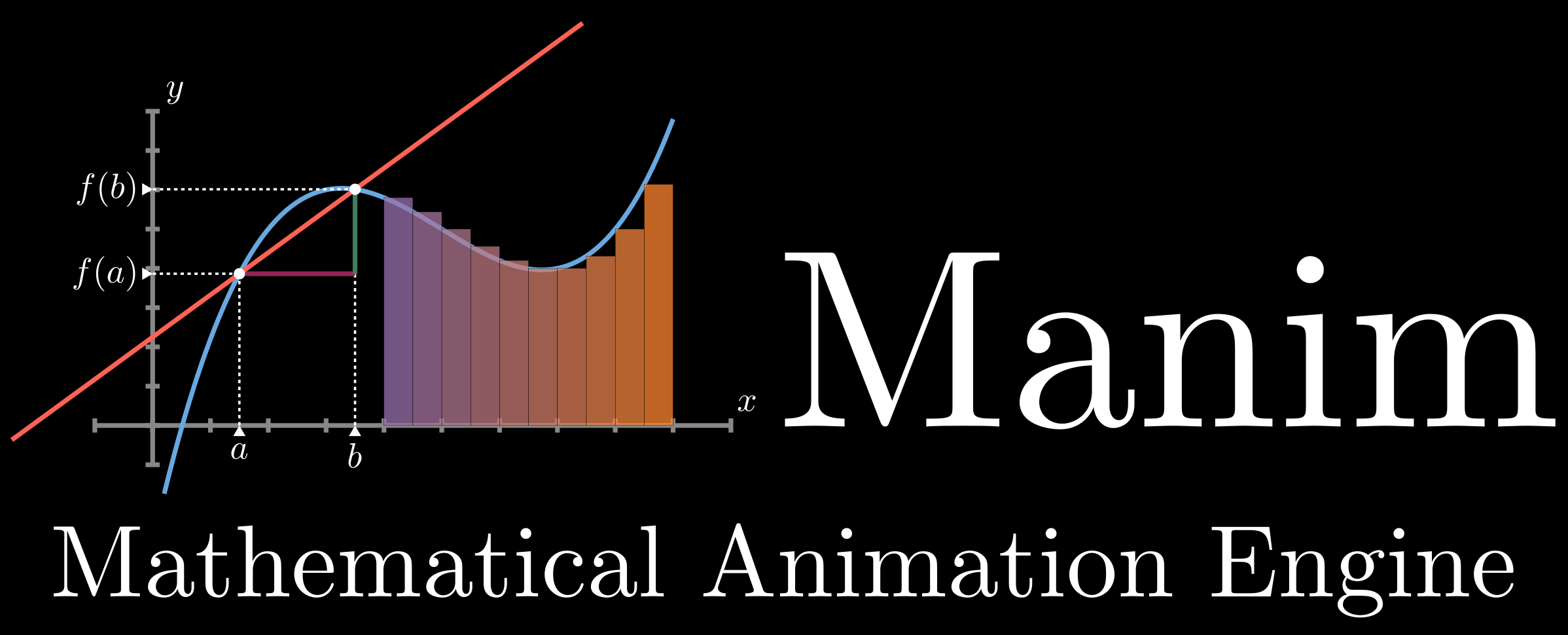Manim is an animation engine for explanatory math videos. It's used to create precise animations programmatically, as seen in the videos at 3Blue1Brown.
This repository contains the version of manim used by 3Blue1Brown. There is also a community maintained version at https://github.com/ManimCommunity/manim/. To get help or to join the development effort, please join the discord.
Installation
Manim runs on Python 3.8.
System requirements are FFmpeg, OpenGL and latex (optional, if you want to use LaTeX).
For more options, take a look at the Using manim sections further below.
Directly
If you want to hack on manimlib itself, clone this repository and in that directory execute:
# Install python requirements
python3 -m pip install -r requirements.txt
# Try it out
python3 ./manim.py example_scenes.py SquareToCircle
Directly (Windows)
- Install FFmpeg.
- Install a LaTeX distribution. MiKTeX is recommended.
- Install the remaining Python packages.
git clone https://github.com/3b1b/manim.git cd manim pip3 install -r requirements.txt python3 manim.py example_scenes.py SquareToCircle
Anaconda Install
- Install latex as above.
- Create a conda environment using
conda env create -f environment.yml - WINDOWS ONLY Install
pyreadlineviapip install pyreadline.
Using virtualenv and virtualenvwrapper
After installing virtualenv and virtualenvwrapper
git clone https://github.com/3b1b/manim.git
mkvirtualenv -a manim -r requirements.txt manim
python3 -m manim example_scenes.py SquareToCircle
Using Docker
Since it's a bit tricky to get all the dependencies set up just right, there is a Dockerfile and Compose file provided in this repo as well as a premade image on Docker Hub. The Dockerfile contains instructions on how to build a manim image, while the Compose file contains instructions on how to run the image.
The prebuilt container image has manim repository included.
INPUT_PATH is where the container looks for scene files. You must set the INPUT_PATH
environment variable to the absolute path containing your scene file and the
OUTPUT_PATH environment variable to the directory where you want media to be written.
- Install Docker
- Install Docker Compose
- Render an animation:
INPUT_PATH=/path/to/dir/containing/source/code \
OUTPUT_PATH=/path/to/output/ \
docker-compose run manim example_scenes.py SquareToCircle -l
The command needs to be run as root if your username is not in the docker group.
You can replace example.scenes.py with any relative path from your INPUT_PATH.
After running the output will say files ready at /tmp/output/, which refers to path inside the container. Your OUTPUT_PATH is bind mounted to this /tmp/output so any changes made by the container to /tmp/output will be mirrored on your OUTPUT_PATH. /media/ will be created in OUTPUT_PATH.
-p won't work as manim would look for video player in the container system, which it does not have.
The first time you execute the above command, Docker will pull the image from Docker Hub and cache it. Any subsequent runs until the image is evicted will use the cached image. Note that the image doesn't have any development tools installed and can't preview animations. Its purpose is building and testing only.
Using manim
Try running the following:
python3 -m manim example_scenes.py SquareToCircle
This should pop up a window playing a simple scene.
Some useful flags include:
-wto write the scene to a file-oto write the scene to a file and open the result-sto skip to the end and just show the final frame.-n <number>to skip ahead to then'th animation of a scene.-fto show the file in finder (for OSX).
Set MEDIA_DIR environment variable to specify where the image and animation files will be written.
Look through https://github.com/3b1b/videos to see the code for previous 3b1b videos. Note, however, that developments are often made to the library without considering backwards compatibility with those old projects. To run an old project with a guarantee that it will work, you will have to go back to the commit which completed that project.
Documentation
Documentation is in progress at eulertour.com/learn/manim.
Walkthrough
Todd Zimmerman put together a tutorial on getting started with manim, which has been updated to run on Python 3.7.
Contributing
Is always welcome. In particular, there is a dire need for tests and documentation.
License
This project falls under the MIT license.





